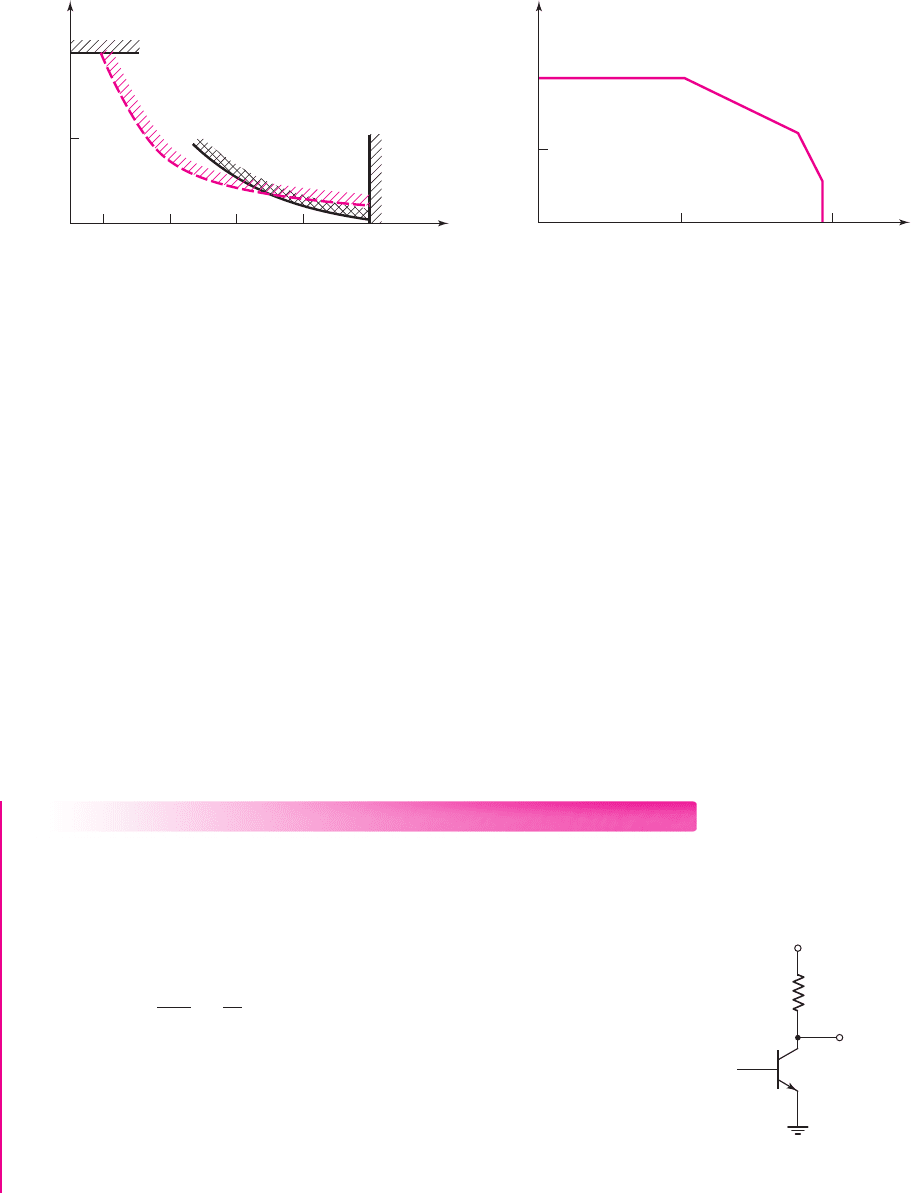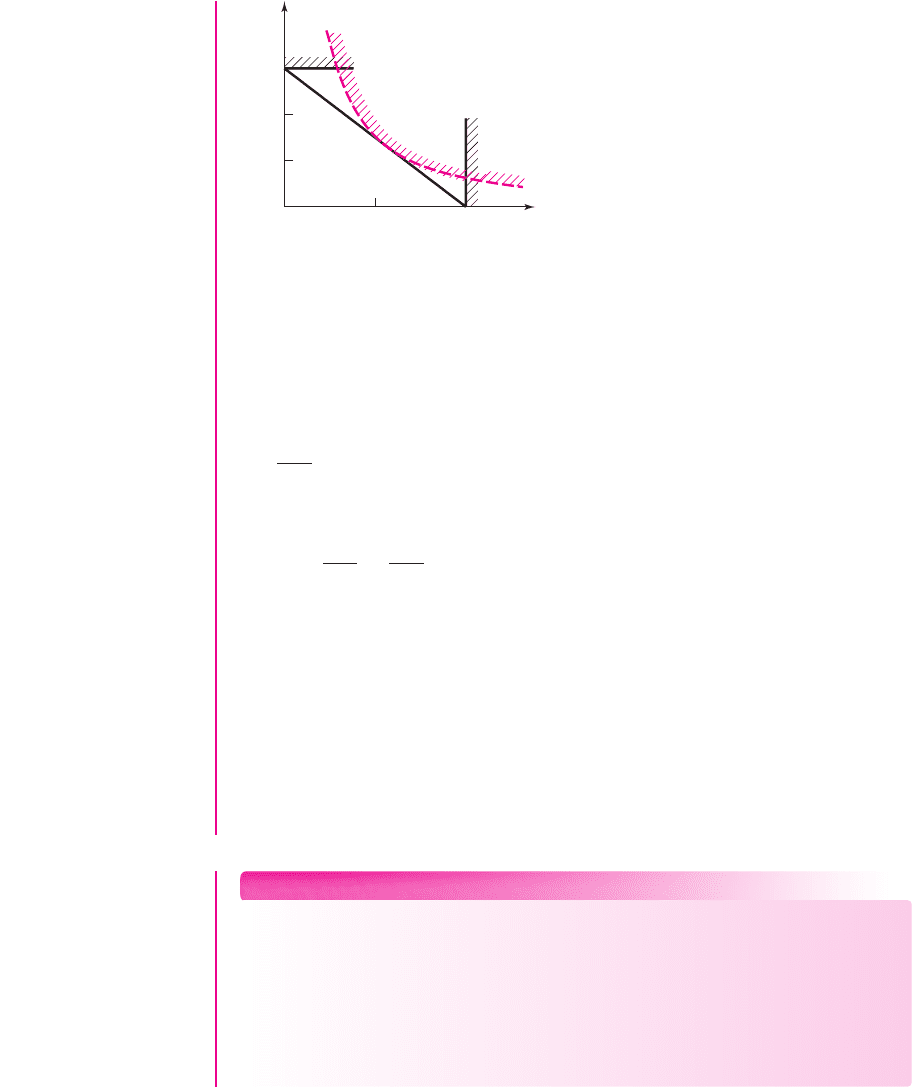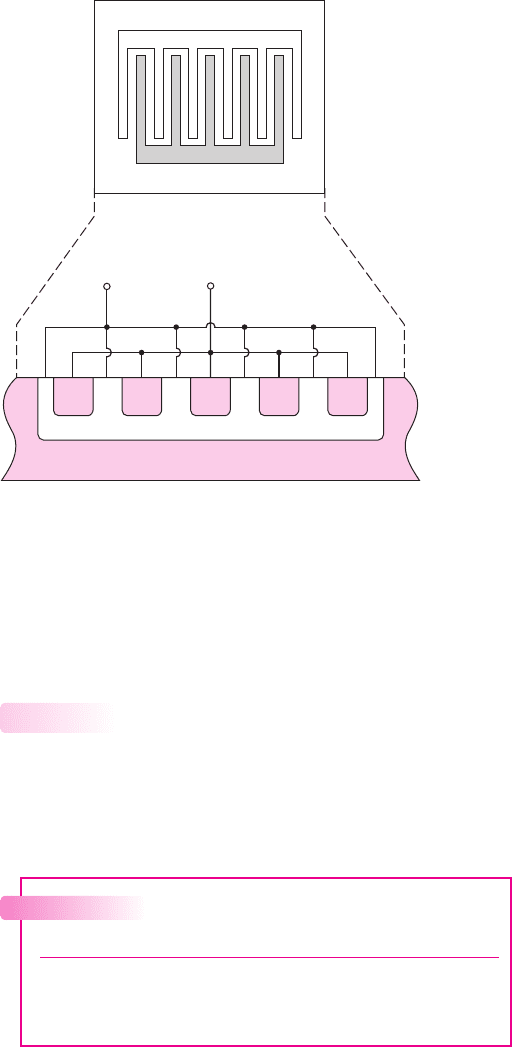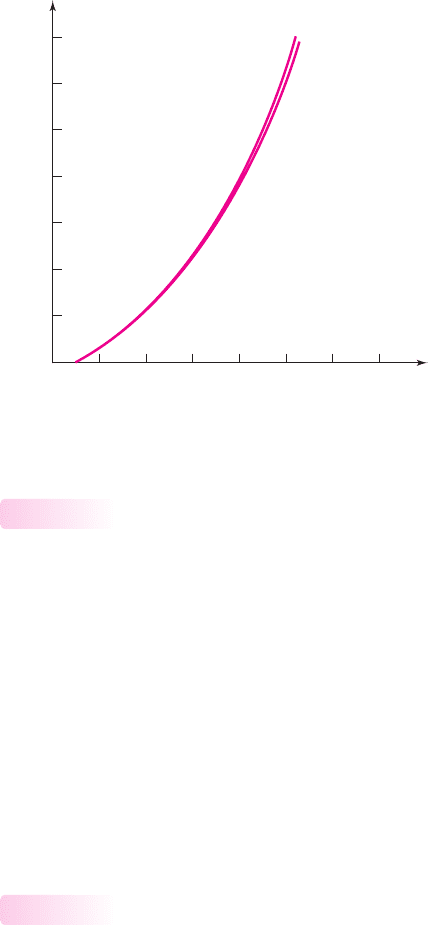Neamen D. Microelectronics: Circuit Analysis and Design
Подождите немного. Документ загружается.


*D7.82 A simplified high-frequency equivalent circuit of a common-emitter ampli-
fier is shown in Figure P7.82. The input signal is coupled into the amplifier
through
C
C1
, the output signal is coupled to the load through
C
C2
, and the
amplifier provides a midband gain of
|
A
m
|
and an upper 3 dB frequency of
f
H
. Compare this single-stage amplifier design to one in which three
amplifier stages are used between the signal and load. In the three-stage
amplifier, assume all parameters are the same, except g
m
for each stage is
one-third that of the single-stage amplifier. Compare the midband gains and
the bandwidths.
558 Part 1 Semiconductor Devices and Basic Applications
r
p
C
p
R
C
V
o
+
–
V
p
R
L
V
i
C
C1
R
S
–
Amplifier stage
+
–
C
C2
C
m
g
m
V
p
Figure P7.82
Table P7.81 Device specifications for Problem 7.81
Device f
T
(MHz) C
μ
(pF) β r
b
()
A 350 2 100 15
B 400 5 100 10
C 500 2 50 5
DESIGN PROBLEMS
[Note: Each design should be verified with a computer analysis.]
*D7.79 (a) Design a common-emitter amplifier using a 2N2222A transistor biased
at
I
CQ
= 1
mA and
V
CEQ
= 10
V. The available power supplies are
±15
V,
the load resistance is
R
L
= 20 k
, the source resistance is
R
S
= 0.5k
,
the input and output are ac coupled to the amplifier, and the lower 3 dB fre-
quency is to be less than 10 Hz. Design the circuit to maximize the midband
gain. What is the upper 3 dB frequency? (b) Repeat the design for
I
CQ
=
50 μA
. Assume
f
T
is the same as the case when
I
CQ
= 1
mA. Compare the
midband gain and bandwidth of the two designs.
*D7.80 Design a bipolar amplifier with a midband gain of
|
A
v
|
= 50
and a lower 3 dB
frequency of 10 Hz. The available transistors are 2N2222A, and the available
power supplies are
±10
V. All transistors in the circuit should be biased at ap-
proximately 0.5 mA. The load resistance is
R
L
= 5k
, the source resistance
is
R
S
= 0.1k
, and the input and output are ac coupled to the amplifier.
Compare the bandwidth of a single-stage design to that of a cascode design.
*D7.81 A common-emitter amplifier is designed to provide a particular midband
gain and a particular bandwidth, using device A from Table P7.81. Assume
I
CQ
= 1
mA. Investigate the effect on midband gain and bandwidth if de-
vices B and C are inserted into the circuit. Which device provides the largest
bandwidth? What is the gain–bandwidth product in each case?
nea80644_ch07_469-558.qxd 06/13/2009 08:08 PM Page 558 F506 Hard disk:Desktop Folder:Rakesh:MHDQ134-07:

Chapter
Output Stages and
Power Amplifiers
8
8
559
In previous chapters, we dealt mainly with small-signal voltage gains, current gains,
and impedance characteristics of linear amplifiers. In this chapter, we analyze and
design circuits that must deliver a specified power to a load. We will, therefore, be
concerned with power dissipation in transistors, especially in the output stage, since
the output stage must deliver the signal power. Linearity in the output signal is still a
priority, however. A figure of merit for the output stage linearity characteristic is the
total harmonic distortion that is present.
Various classes of power amplifiers are defined. The ideal and actual power effi-
ciencies of these classes of amplifiers are determined.
PREVIEW
In this chapter, we will:
• Describe the concept of a power amplifier.
• Describe the characteristics of BJT and MOSFET power transistors, and an-
alyze the temperature and heat flow characteristics of devices using heat
sinks.
• Define the various classes of power amplifiers and determine the maximum
power efficiency of each class of amplifier.
• Analyze several circuit configurations of class-A power amplifiers.
• Discuss the characteristics of an ideal class-B output stage.
• Analyze and design various circuit configurations of class-AB output stages.
• As an application, design an output stage using MOSFETs as the output
devices.
nea80644_ch08_559-614.qxd 06/15/2009 01:31 PM Page 559 F506 Hard disk:Desktop Folder:ALI:MHDQ134-08 Folder:MHDQ134-08:

560 Part 1 Semiconductor Devices and Basic Applications
8.1 POWER AMPLIFIERS
Objective: • Describe the concept of a power amplifier.
A multistage amplifier may be required to deliver a large amount of power to a
passive load. This power may be in the form of a large current delivered to a rela-
tively small load resistance such as an audio speaker, or may be in the form of a large
voltage delivered to a relatively large load resistance such as in a switching power
supply. The output stage of the power amplifier must be designed to meet the power
requirements. In this chapter, we are interested only in power amplifiers using BJTs
or MOSFETS, and will not consider other types of power electronics that, for exam-
ple, use thyristors.
Two important functions of the output stage are to provide a low output resis-
tance so that it can deliver the signal power to the load without loss of gain and to
maintain linearity in the output signal. A low output resistance implies the use of
emitter-follower or source-follower circuit configurations. A measure of the linearity
of the output signal is the total harmonic distortion (THD). This figure of merit is
the rms value of the harmonic components of the output signal, excluding the funda-
mental, expressed as a percentage of the fundamental.
A particular concern in the design of the output stage is to deliver the required
signal power to the load efficiently. This specification implies that the power dissi-
pated in the transistors of the output stage should be as small as possible. The output
transistors must be capable of delivering the required current to the load, and must be
capable of sustaining the required output voltage.
We will initially discuss power transistors and will then consider several output
stages of power amplifiers.
8.2 POWER TRANSISTORS
Objective: • Describe the characteristics of BJT and MOSFET power
transistors, and analyze the temperature and heat flow characteristics
of devices using heat sinks.
In our previous discussions, we have ignored any physical transistor limitations in
terms of maximum current, voltage, and power. We implicitly assumed that the
transistors were capable of handling the current and voltage, and could handle the
power dissipated within the transistor without suffering any damage.
However, since we are now discussing power amplifiers, we must be concerned
with transistor limitations. The limitations involve: maximum rated current (on the
order of amperes), maximum rated voltage (on the order of 100 V), and maximum
rated power (on the order of watts or tens of watts).
1
We will consider these effects
in the BJT and then in the MOSFET. The maximum power limitation is related to the
1
We must note that, in general, the maximum rated current and maximum rated voltage cannot occur at the
same time.
nea80644_ch08_559-614.qxd 06/15/2009 01:31 PM Page 560 F506 Hard disk:Desktop Folder:ALI:MHDQ134-08 Folder:MHDQ134-08:

Chapter 8 Output Stages and Power Amplifiers 561
Table 8.1 Comparison of the characteristics and maximum
ratings of a small-signal and power BJT
Power
Small-Signal BJT Power BJT BJT
Parameter (2N2222A) (2N3055) (2N6078)
V
CE
(max)
(V) 40 60 250
I
C
(max)
(A) 0.8 15 7
P
D
(max)
(W) (at T
=
25 °C) 1.2 115 45
β 35–100 5–20 12–70
f
T
(MHz) 300 0.8 1
1000
500
300
100
50
30
10
5
3
0.01 0.03 01
–55
25
Common emitter
V
CE
= 4 V
T
C
= 100 °C
03
Collector current I
C
(A)
DC current gain h
FE
1 3 10 20
Figure 8.1 Typical dc beta characteristics (h
FE
versus I
C
) for 2N3055
maximum allowed temperature of the transistor, which in turn is a function of the
rate at which heat is removed. We will therefore briefly consider heat sinks and heat
flow.
Power BJTs
Power transistors are large-area devices. Because of differences in geometry and
doping concentrations, their properties tend to vary from those of the small-signal
devices. Table 8.1 compares the parameters of a general-purpose small-signal BJT to
those of two power BJTs. The current gain is generally smaller in the power transis-
tors, typically in the range of 20 to 100, and may be a strong function of collector
current and temperature. Figure 8.1 shows typical current gain versus collector cur-
rent characteristics for the 2N3055 power BJT at various temperatures. At high
current levels, the current gain tends to drop off significantly, and parasitic resis-
tances in the base and collector regions may become significant, affecting the
transistor terminal characteristics.
The maximum rated collector current I
C,rated
may be related to: the maximum
current that the wires connecting the semiconductor to the external terminals can
handle; the collector current at which the current gain falls below a minimum speci-
fied value; or the current that leads to the maximum power dissipation when the tran-
sistor is in saturation.
8.2.1
nea80644_ch08_559-614.qxd 06/15/2009 01:31 PM Page 561 F506 Hard disk:Desktop Folder:ALI:MHDQ134-08 Folder:MHDQ134-08:

562 Part 1 Semiconductor Devices and Basic Applications
1
2
3
4
5
6
7
8
9
10
0 20 40 60 80 100 120 140
Collector current I
C
(mA)
Collector-to-emitter voltage V
CE
(V)
I
B
= 75
60
45
30
15
Base current I
B
= 0 mA
Figure 8.2 Typical collector current versus collector–emitter voltage characteristics of a
bipolar transistor, showing breakdown effects
The maximum voltage limitation in a BJT is generally associated with avalanche
breakdown in the reverse-biased base–collector junction. In the common-emitter
configuration, the breakdown voltage mechanism also involves the transistor gain,
as well as the breakdown phenomenon on the pn junction. Typical I
C
versus
V
CE
characteristics are shown in Figure 8.2. The breakdown voltage when the base termi-
nal is open circuited (
I
B
= 0
) is
V
CEO
. From the data in Figure 8.2, this value is ap-
proximately 130 V.
When the transistor is biased in the active region, the collector current begins to
increase significantly before breakdown voltage
V
CEO
is reached, and all the curves
tend to merge to the same collector–emitter voltage once breakdown has occurred.
The voltage at which these curves merge is denoted
V
CE
(sus)
and is the minimum
voltage necessary to sustain the transistor in breakdown. From the data in Figure 8.2,
the value of
V
CE
(sus)
is approximately 115 V.
Another breakdown effect is called second breakdown, which occurs in a BJT
operating at high voltage and a fairly high current. Slight nonuniformities in current
density produce local regions of increased heating that decreases the resistance of the
semiconductor material, which in turn increases the current in those regions. This
effect results in positive feedback, and the current continues to increase, producing a
further increase in temperature, until the semiconductor material may actually melt,
creating a short circuit between the collector and emitter and producing a permanent
failure.
The instantaneous power dissipation in a BJT is given by
p
Q
= v
CE
i
C
+v
BE
i
B
(8.1)
The base current is generally much smaller than the collector current; therefore, to a
good approximation, the instantaneous power dissipation is
p
Q
∼
=
v
CE
i
C
(8.2)
The average power, which is found by integrating Equation (8.2) over one cycle of
the signal, is
¯
P
Q
=
1
T
T
0
v
CE
i
C
dt
(8.3)
nea80644_ch08_559-614.qxd 06/15/2009 01:31 PM Page 562 F506 Hard disk:Desktop Folder:ALI:MHDQ134-08 Folder:MHDQ134-08:

Chapter 8 Output Stages and Power Amplifiers 563
I
C
(A)
V
CE, (sus)
V
CE
(V)
1 100
10
0.10
0.01
1.0
Maximum
current limit
Second
breakdown
P
T
(b)
I
C
(A)
V
CE,
(sus)
I
C, max
P
T
V
CE
(V)
10 30 50 70 90
0
0.5
1.0
Second
breakdown
(a)
Figure 8.3 The safe operating area of a bipolar transistor plotted on: (a) linear scales and
(b) logarithmic scales
The average power dissipated in a BJT must be kept below a specified maximum
value, to ensure that the temperature of the device remains below a maximum value.
If we assume that the collector current and collector–emitter voltage are dc quanti-
ties, then at the maximum rated power P
T
for the transistor, we can write
P
T
= V
CE
I
C
(8.4)
The maximum current, voltage, and power limitations can be illustrated on the
I
C
versus V
CE
characteristics, as shown in Figure 8.3. The average power limitation
P
T
is a hyperbola described by Equation (8.4). The region where the transistor can be
operated safely is known as the safe operating area (SOA) and is bounded by
I
C,max
, V
CE(sus)
, P
T
, and the transistor’s second breakdown characteristics curve.
Figure 8.3(a) shows the safe operating area, using linear current and voltage scales;
Figure 8.3(b) shows the same characteristics using logarithmic scales.
The i
C
–v
CE
operating point may move momentarily outside the safe operating
area without damaging the transistor, but this depends on how far the Q-point moves
outside the area and for how long. For our purposes, we will assume that the device
must remain within the safe operating area at all times.
EXAMPLE 8.1
Objective: Determine the required current, voltage, and power ratings of a power
BJT.
Consider the common-emitter circuit in Figure 8.4. The parameters are
R
L
= 8
and
V
CC
= 24
V.
Solution: For
V
CE
∼
=
0
, the maximum collector current is
I
C
(max) =
V
CC
R
L
=
24
8
= 3A
For
I
C
= 0
, the maximum collector–emitter voltage is
V
CE
(max) = V
CC
= 24 V
The load line is given by
V
CE
= V
CC
− I
C
R
L
and must remain within the safe operating area, as shown in Figure 8.5.
R
L
v
O
v
I
V
CC
Figure 8.4 Figure for
Example 8.1
nea80644_ch08_559-614.qxd 06/15/2009 01:31 PM Page 563 F506 Hard disk:Desktop Folder:ALI:MHDQ134-08 Folder:MHDQ134-08:

564 Part 1 Semiconductor Devices and Basic Applications
I
C
(A)
V
CE, (sus)
I
C, max
V
CE
(V)
12 24
3
0
1
2
Figure 8.5 DC load line within the safe operating area
The transistor power dissipation is therefore
P
T
= V
CE
I
C
= (V
CC
− I
C
R
L
)I
C
= V
CC
I
C
− I
2
C
R
L
The current at which the maximum power occurs is found by setting the derivative of
this equation equal to zero as follows:
dP
T
dI
C
= 0 = V
CC
−2I
C
R
L
which yields
I
C
=
V
CC
2R
L
=
24
2(8)
= 1.5A
The C–E voltage at the maximum power point is
V
CE
= V
CC
− I
C
R
L
= 24 −(1.5)(8) = 12 V
The maximum power dissipation in the transistor occurs at the center of the load line.
The maximum transistor power dissipation is therefore
P
T
= V
CE
I
C
= 12(1.5) = 18 W
Comment: To find a transistor for a given application, safety factors are normally
used. For this example, a transistor with a current rating greater than 3 A, a voltage
rating greater than 24 V, and a power rating greater than 18 W would be required.
EXERCISE PROBLEM
Ex 8.1: Consider the common-emitter circuit shown in Figure 8.4. Assume the
transistor has limiting factors of:
I
C,max
= 5
A,
V
CE
(
sus
)
= 30
V, and
P
T
= 25
W.
Neglecting second breakdown effects, determine the minimum
R
L
such that the
Q
-point of the transistor stays within the safe operating area for: (a)
V
CC
= 24
V
and (b)
V
CC
= 12
V. In each case, determine the maximum collector current and
maximum transistor power dissipation. (Ans. (a)
R
L
= 5.76
,
I
C,max
= 4.17
A,
P
Q,max
= 25
W; (b)
R
L
= 2.4
,
I
C,max
= 5
A,
P
Q,max
= 15
W)
Power transistors, which are designed to handle large currents, require large
emitter areas to maintain reasonable current densities. These transistors are usually
designed with narrow emitter widths to minimize the parasitic base resistance,
nea80644_ch08_559-614.qxd 06/15/2009 01:31 PM Page 564 F506 Hard disk:Desktop Folder:ALI:MHDQ134-08 Folder:MHDQ134-08:

Chapter 8 Output Stages and Power Amplifiers 565
and may be fabricated as an interdigitated structure, as shown in Figure 8.6. Also,
emitter ballast resistors, which are small resistors in each emitter leg, are usually
incorporated in the design. These resistors help maintain equal currents in each B–E
junction.
Power MOSFETs
Table 8.2 lists the basic parameters of two n-channel power MOSFETs. The drain
currents are in the ampere range and the breakdown voltages are in the hundreds of
volts range. These transistors must also operate within a safe operating area as
discussed for the BJTs.
8.2.2
Base
Emitter
Base
terminal
p base
Emitter
terminal
Figure 8.6 An interdigitated bipolar transistor structure showing the top view and cross-
sectional view
Table 8.2 Characteristics of two power MOSFETs
Parameter 2N6757 2N6792
V
DS
(max) (V) 150 400
I
D
(max) (at T
=
25 °C) 8 2
P
D
(W) 75 20
Power MOSFETs differ from bipolar power transistors both in operating princi-
ples and performance. The superior performance characteristics of power MOSFETs
are: faster switching times, no second breakdown, and stable gain and response
time over a wide temperature range. Figure 8.7(a) shows the transconductance
nea80644_ch08_559-614.qxd 06/15/2009 01:31 PM Page 565 F506 Hard disk:Desktop Folder:ALI:MHDQ134-08 Folder:MHDQ134-08:

566 Part 1 Semiconductor Devices and Basic Applications
10
8
6
4
2
0 246810
Transconductance (siemens)
Drain current I
D
(A)
10
8
6
4
2
0
80 ms pulse test
80 ms pulse test
1234567
Drain current I
D
(A)
Gate-to-source voltage (V)
(b)(a)
T
J
= –55 °C
T
J
= 25 °C
T
J
= –55 °C
T
J
= 25 °C
T
J
= 125 °C
T
J
= +125 °C
V
DS
= 15 V
V
DS
= 15 V
Figure 8.7 Typical characteristics for high-power MOSFETs: (a) transconductance versus
drain current; (b) transfer characteristics
of the 2N6757 versus temperature. The variation with temperature of the MOSFET
transconductance is less than the variation in the BJT current gain shown in Figure 8.1.
Power MOSFETs are often manufactured by a vertical or double-diffused
process, called VMOS or DMOS, respectively. The cross section of a VMOS device
is shown in Figure 8.8(a) and the cross section of the DMOS device is shown in
Figure 8.8(b). The DMOS process can be used to produce a large number of closely
packed hexagonal cells on a single silicon chip, as shown in Figure 8.8(c). Also, such
MOSFETs can be paralleled to form large-area devices, without the need of an equiv-
alent emitter ballast resistance to equalize the current density. A single power
MOSFET chip may contain as many as 25,000 paralleled cells.
Since the path between the drain and the source is essentially resistive, the on
resistance r
ds
(on) is an important parameter in the power capability of a MOSFET.
Figure 8.9 shows a typical r
ds
(on) characteristic as a function of drain current. Values
in the tens of milliohm range have been obtained.
Source
Source Source
SourceGate
Gate
Channel
Channel
p-base
p-base
n-drift region n-drift region
p
p
n
+
n
+
n
+
n
+
n
+
n
+
Drain Drain
(a) (b) (c)
Drain
metallization
Multiple source cells
interconnected by
metallization
Multiple
source cells
Silicon gate
n
+
p
L
W
n
tnerrucniarD
Figure 8.8 (a) Cross section of a VMOS device; (b) cross section of DMOS device;
(c) HEXFET structure
nea80644_ch08_559-614.qxd 06/15/2009 01:31 PM Page 566 F506 Hard disk:Desktop Folder:ALI:MHDQ134-08 Folder:MHDQ134-08:

Chapter 8 Output Stages and Power Amplifiers 567
0.3
0.4
0.5
0.6
0.7
0.8
0.9
1.0
100 203040506070
R
DS(on)
, drain-to-source on resistance (
Ω
)
R
DS(on)
, measured with current
pulse of 2.0
m
s duration
initial T
j
= 25 °C (heating
effect of 2.0
m
s pulse is minimal)
I
D
, drain current (A)
V
GS
= 10 V
V
GS
= 20 V
Figure 8.9 Typical drain-to-source resistance versus drain current characteristics of a
MOSFET
Comparison of Power MOSFETs and BJTs
Since a MOSFET is a high input impedance, voltage-controlled device, the drive cir-
cuitry is simpler. The gate of a 10 A power MOSFET may be driven by the output of
a standard logic circuit. In contrast, if the current gain of a 10 A BJT is
β = 10
, then
a base current of 1 A is required for a collector current of 10 A. However, this
required input current is much larger than the output drive capability of most logic
circuits, which means that the drive circuitry for power BJTs is more complicated.
The MOSFET is a majority carrier device. Majority carrier mobility decreases
with increasing temperature, which makes the semiconductor more resistive. This
means that MOSFETs are more immune to the thermal runaway effects and second
breakdown phenomena experienced in bipolars. Figure 8.7(b) shows typical I
D
versus
V
GS
characteristics at several temperatures, clearly demonstrating that at high
current levels, the current actually decreases with increasing temperature, for a given
gate-to-source voltage.
Heat Sinks
The power dissipated in a transistor increases its internal temperature above the
ambient temperature. If the device or junction temperature T
j
becomes too high, the
transistor may suffer permanent damage. Special precautions must be taken in pack-
aging power transistors and in providing heat sinks so that heat can be conducted
from the transistor. Figures 8.10(a) and (b) show two packaging schemes, and Fig-
ure 8.10(c) shows a typical heat sink.
To design a heat sink for a power transistor, we must first consider the concept
of thermal resistance
θ
, which has units of °C/W. The temperature difference,
T
2
− T
1
, across an element with a thermal resistance
θ
is
T
2
− T
1
= Pθ
(8.5)
8.2.4
8.2.3
nea80644_ch08_559-614.qxd 06/15/2009 01:31 PM Page 567 F506 Hard disk:Desktop Folder:ALI:MHDQ134-08 Folder:MHDQ134-08:
